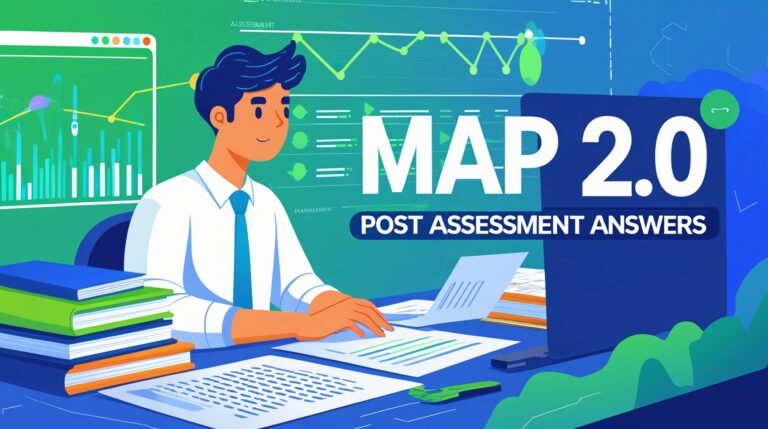Education has shifted dramatically in recent years, with online learning and assessment tools becoming central to academic success. Among these resources, Map 2.0 post assessments stand out as a benchmark for measuring student progress and mastery of concepts. Many learners and educators actively seek reliable answer keys to guide their preparation and improve results. However, understanding the value behind the Map 2.0 post assessment answers goes beyond simply memorizing responses—it involves appreciating the system’s design, purpose, and how it supports growth.
This article serves as a comprehensive guide for students, teachers, and parents in the U.S., U.K., and other English-speaking countries. By exploring the structure, background, and insights of the Map 2.0 framework, we’ll uncover how answer keys can be used ethically as study aids rather than shortcuts.
The Story Behind Map 2.0 Assessments

To understand the significance of the answer keys, it’s important to look back at the origins of the Map Growth assessment system. Developed to provide personalized evaluations, Map 2.0 was created with the goal of adapting questions to each student’s level. Rather than offering a one-size-fits-all test, it tailors itself in real time, delivering results that better reflect true ability.
The “post assessment” portion comes at the end of a learning cycle. It acts as both a checkpoint and a roadmap, showing where a student has excelled and where more practice is needed. Answer keys for these assessments became popular study tools, giving learners a way to cross-check their work and identify patterns in their mistakes.
Why Students Search for Map 2.0 Post Assessment Answers
The demand for answer keys is fueled by a variety of reasons. Some students look for them as a quick way to verify accuracy after completing a practice test. Others use them to prepare for future assessments by recognizing common question structures and solution strategies.
Educators also turn to these resources, not to hand students direct solutions, but to analyze performance gaps and plan targeted lessons. Parents, particularly in top-tier countries such as the U.S. and U.K., find them useful for guiding at-home study sessions. Instead of acting as shortcuts, these keys are better viewed as supplementary tools that promote confidence and reinforce skills.
How the Answer Keys Are Structured
Most Map 2.0 post assessment answer guides follow a clear, student-friendly layout. Typically, they are divided by subject areas such as mathematics, reading comprehension, and language usage. Within each section, you’ll find numbered responses aligned with corresponding test questions.
Some enhanced versions go beyond simple right-or-wrong entries and provide explanations for why certain answers are correct. These explanation-based keys are especially helpful for learners who struggle with reasoning skills, as they highlight problem-solving methods instead of rote memorization.
Benefits of Using Map 2.0 Answer Keys Responsibly
While the misuse of answer keys can undermine genuine learning, responsible use brings several educational benefits.
-
Self-Assessment: Students can measure their own progress and identify weak areas.
-
Error Correction: Checking responses encourages reflection and prevents repeating mistakes.
-
Exam Readiness: Familiarity with the structure of questions reduces anxiety during formal assessments.
-
Parental Support: Parents gain a clearer view of their child’s academic standing and can provide targeted encouragement.
-
Teaching Aid: Instructors can use them as templates for practice sessions or review lessons.
These advantages reinforce the idea that Map 2.0 post assessment answers are most powerful when treated as learning aids, not shortcuts.
Common Challenges Students Face with Map 2.0
Despite its benefits, Map 2.0 assessments pose certain difficulties that make answer keys appealing. Some students feel overwhelmed by the adaptive nature of the test, where questions become more challenging with each correct answer. Others may struggle with time management, particularly in sections requiring critical reading and reasoning.
Language barriers also play a role, especially for learners who are not native English speakers. In such cases, answer keys provide clarity, allowing students to break down difficult passages and grasp underlying patterns in the test.
Real-Life Stories: Students and Teachers Using Map 2.0 Keys
To illustrate the impact, let’s consider the experiences of two learners:
-
Emily, a high school student in Chicago, initially struggled with algebraic problem-solving. By reviewing detailed explanations from a Map 2.0 post assessment answer key, she discovered new ways to approach word problems, which raised her confidence and boosted her test scores.
-
James, a secondary school teacher in London, used answer guides not to hand out solutions but to design workshops. He highlighted frequent errors students made, then built lessons around correcting them. This approach led to improved engagement and better outcomes for his class.
Stories like these highlight the transformational potential of using answer keys as a constructive educational resource.
Ethical Use of Map 2.0 Answer Keys
A recurring question among students and educators is whether using answer keys counts as “cheating.” The answer depends on intent. If a student simply copies responses without learning the reasoning, the tool becomes harmful. However, when keys are used after an honest attempt at solving, they serve as a powerful feedback mechanism.
Educators emphasize that true academic growth requires critical thinking. In fact, most schools encourage the use of practice materials, provided students reflect on errors and apply corrections. The ethical path lies in balancing convenience with commitment to learning.
Alternatives to Direct Answer Keys
For those who prefer not to rely heavily on published answer keys, several alternatives exist:
-
Practice Platforms: Interactive websites and apps simulate Map-style questions while offering hints instead of full solutions.
-
Study Groups: Collaborating with peers allows students to exchange reasoning strategies.
-
Teacher Feedback: Requesting targeted support from instructors often yields deeper understanding than self-study alone.
These approaches can be combined with post assessment answers to create a well-rounded study plan.
The Future of Map Assessments and Digital Learning
Looking ahead, the evolution of Map 2.0 assessments reflects broader trends in education. As classrooms become increasingly digital, adaptive testing systems will continue to grow. Future versions may integrate real-time tutoring, advanced analytics, and personalized lesson plans.
For now, students and teachers should view Map 2.0 answer keys as stepping stones toward mastering concepts rather than shortcuts. With the right balance of technology and human guidance, these tools can make learning more engaging and measurable.
Final Thoughts
The journey through education is not just about grades but about developing skills that last a lifetime. Map 2.0 post assessment answers are more than just a set of correct responses—they are resources that reveal how students think, what they understand, and where they can grow.
When used responsibly, answer keys empower learners, support educators, and give parents a clearer view of academic progress. In top-tier countries like the U.S. and U.K., where competitive education standards are high, such resources serve as valuable companions on the path to academic achievement.
By treating them as guides rather than shortcuts, students unlock their potential while maintaining integrity in their learning journey.
Frequently Asked Questions (FAQs)
1. What is the purpose of Map 2.0 post assessments?
Map 2.0 post assessments are designed to measure a student’s progress after a learning cycle. They adapt to the learner’s skill level, offering a personalized snapshot of strengths and weaknesses. This helps educators plan the next steps for improvement.
2. How can students use answer keys without relying on them too much?
Students should first attempt to solve all questions independently. Once finished, they can compare their responses to the answer key, identify mistakes, and review explanations. This approach builds both confidence and comprehension.
3. Are Map 2.0 post assessment answers the same across all schools?
Not always. While the general format remains consistent, the exact questions can vary based on grade level, subject, and curriculum alignment. That’s why answer keys should be used mainly for practice, not as exact replicas of test content.
4. Can parents use Map 2.0 answer keys to support their children?
Yes. Parents can use answer keys to guide study sessions at home. By checking accuracy and discussing explanations, they can provide encouragement while ensuring their child understands core concepts.
5. Are there risks in misusing answer keys?
Yes. Over-reliance on answer keys can prevent true learning and create false confidence. Students may memorize answers without grasping concepts, which can hurt long-term performance. The best practice is to use them as study aids rather than shortcuts.
For More Update and Stories Visit: GOLDEN MAGAZINE


